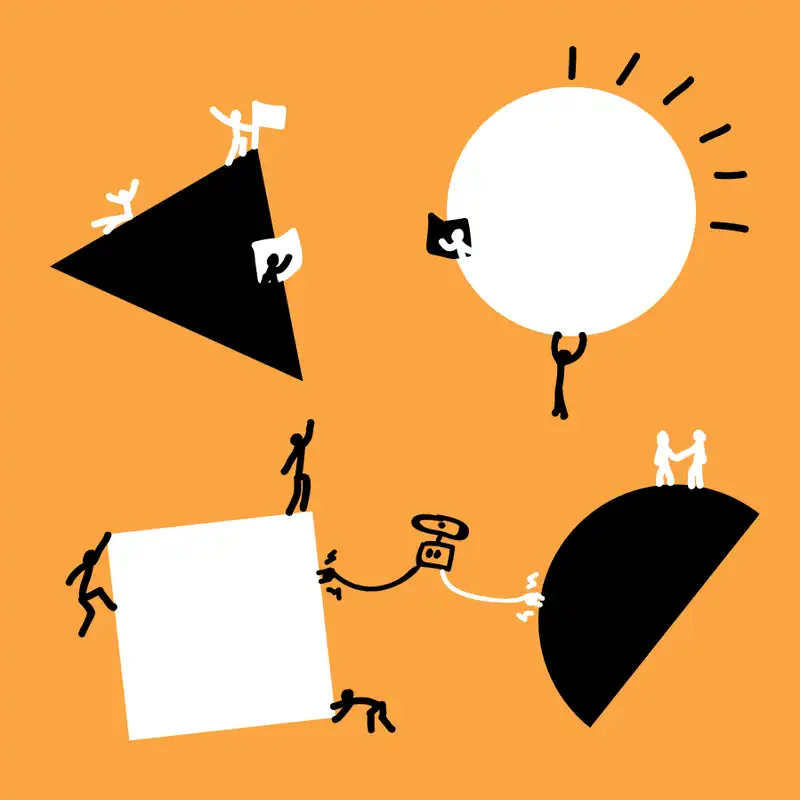Stage
Understand/ Observe
Suggested time
30 minutes
Participants
Scoping team
Stakeholders and/or target users
Facilitator
How to run:
Perspective cards is a quick activity to help you gain insight into how your product’s stakeholders or users see your product from their angle and perspective. A handy activity to do when you are feeling a little disjointed.

- Take the deck of cards and give it to your group. You can use more decks if you have a larger number participating.
- Pose a question to the group, they can be ones like: What cards best represent the product to you? What cards do you prefer? Rank them in order. You can even have people try to think from another person’s perspective when sorting. Seeing what stakeholders believe their users are thinking compared to others on the team can provide great insight.
- Give the group a few minutes to sort the cards out, grabbing ones they believe answer the question posed.
- Have the members explain their selections. Taking note why they picked certain cards over others.
Description
Empathy is one of the key skills of a good designer, and by extension a good scoping team. Being able to understand how your users think and act opens your mind to a whole new range of possibilities. How you might approach a situation is wholly dependent on your collective experience as a human; experiences which may be very different to those you are trying to support and build for.
It is very important to get to know how these people think and tackle problems, so you can offer a solution they would consider viable and enjoyable. Even when you are not building for anyone outside your office, it is still important to understand how your stakeholders feel about the project and what they envision.
This activity is a simple one which helps those who have trouble understanding or sharing their perspective on things. Rather than using words or being put on the spot to consider things that are instinctual, they can be mindful of selecting from just a handful of cards to help show what they are thinking.
The scoping team can gain some amazing insight into how everyone else is thinking and considering the same problem they trying to solve. It is even a good idea to do the activity as a scoping team first, then seeing just how close you were when the stakeholders or users did it. Seeing how close you aligned to their perspective, can help you reposition yourselves to design a product that meets their needs.
Method
Set up the space
Before you start, decide whether you want to see what your stakeholders or users are thinking. You can do this in the same session, but there can be a bias when an employee must go up alongside their employer. If the users and the stakeholders are separate, then feel free to run it as one large session. You’ll be amazed at how quickly product owners change their mind on things when their potential customers are saying something different to them.
Organise the space into breakout tables. If you are going digital, then have everyone in a different virtual room or board. Make sure there is enough room for quiet discussion without it getting too loud. Then give each space the deck of cards and let them sort them out into a pile everyone can see and access.
The card deck
Depending on how you want to run this activity you have a wide number of options for the deck.
- Standard picture and word deck - This is the normal deck we use it contains a series of images and a few words and symbols. It is good for seeing what people think about an idea
- Persona deck - The is deck is filled with a wide variety of personalities and personas that can help you try and understand an idea from their angle
- Self-made - This deck is made by you with some blank study cards. Draw a series of images and add your own words to them that relate directly to what you’re work on. This deck is good for when you know the participants would prefer to think in their area of expertise or if your problem is very targeted at a certain market.
Pose a question
After this you should explain the activity and the importance to understanding how you want to see what everyone thinks about the project. Pose the question to the group and answer any questions they have for clarification. There are many different questions you can ask them to pull out different perspectives. Here are a few examples:
When you hear the words ____ what 4 cards best describe your reaction?
When faced with the problem of ____ what cards best describe how you feel about that?
When you think about this project, what outcomes do you want?
What are the 4 most important cards to you?
How do you think people will respond to this product?
What feelings do you want to have when using this product?
Sort the cards
Give the groups a chance to sort their own cards out. By limiting the possible cards each person has access too, especially if people are sharing the same deck, you are forcing them to think a bit more abstractly and from different angles. Be wary of giving them too long, as people tend to over think things if given too much time. You are looking for their reactions to your questions, not a well-thought out political answer. It is up to you if you allow the groups to talk during time.
Present the outcomes
Once the time is up, have each person hold up their cards and show everyone, explaining what they choose and why. Stick the cards to a board or record them somewhere. Allow the teams a chance to discuss the different results from the question. During this stage it is important as a facilitator to ensure the conversation remains civil. Especially if some perspectives might not have been ones people were expecting.
From here you want to thank the groups and gather your scoping team again to go over what they learnt. Looking for differences between first assumptions and outcomes. How different people saw the question and explained their reasoning. This can help realign your team or give stakeholders a chance to see first-hand how their users are thinking.
Variants
There are several variants you can run with the activity. Here are a few we have tried:
- Give each person a card with a different persona and have them answer the questions from that angle.
- Do the activity in rounds where the group answers by themselves, then those in the group get together and answer the question again with just the selected cards. Allowing for discussion on what cards to pick for the second time. You can then do a third time, bringing all the groups together and letting them pick from the reduced cards again (discarding any duplicates). This can give the whole group a unified perspective on the question.
- Ask everyone to answer the question with an advantage or disadvantage. Maybe they only have access to half the money they currently have or maybe double! Or if they had to answer from an environment they aren’t normally in, such as what if they had to access to the product overseas while travelling? Or from a rural town if they are from a large city.
- Have them order their selected cards in preference. Then take away their bottom cards and see if they are still happy with the product only producing the top cards. It helps them reorder what they consider important. Keep going until there is just one card left. Are they happy with just that one feeling?




